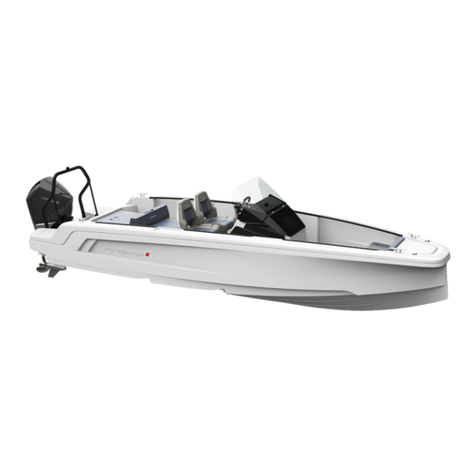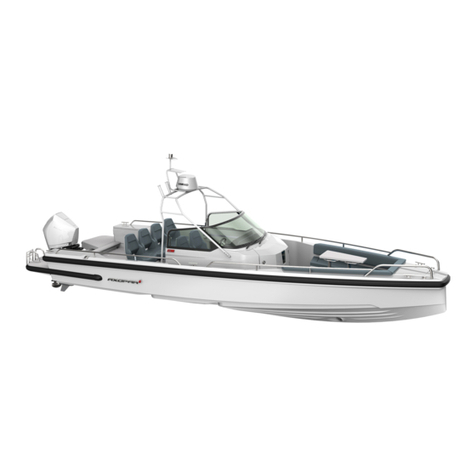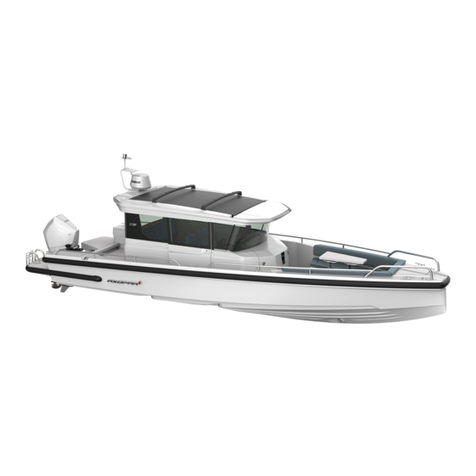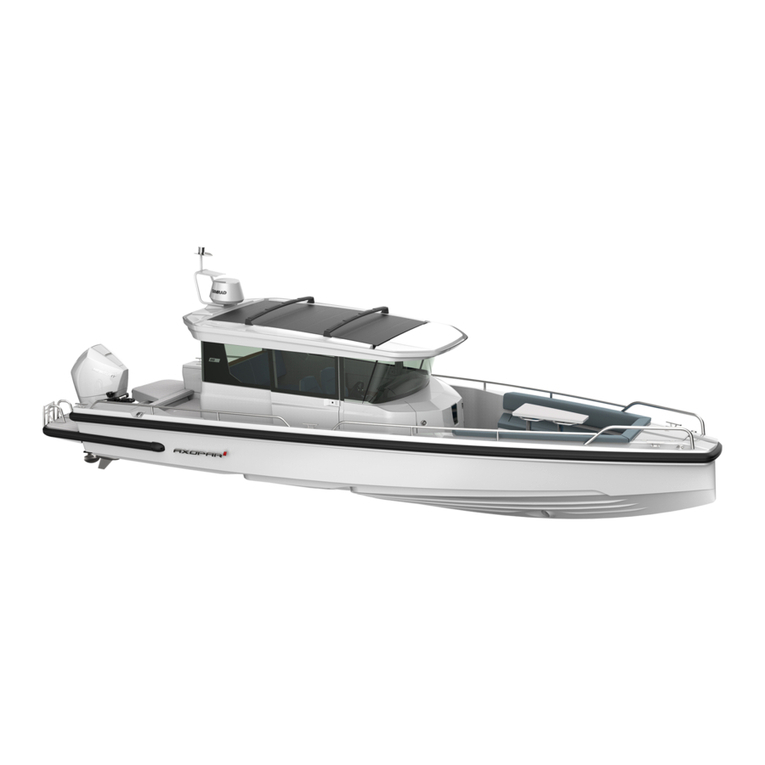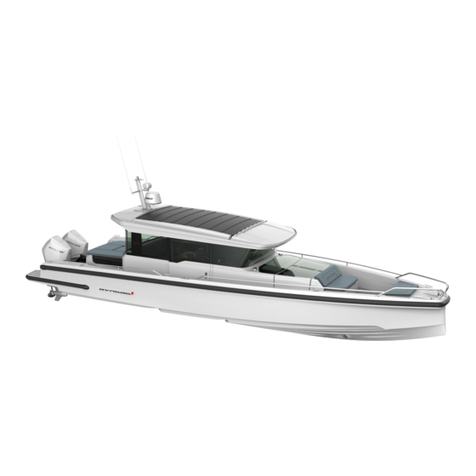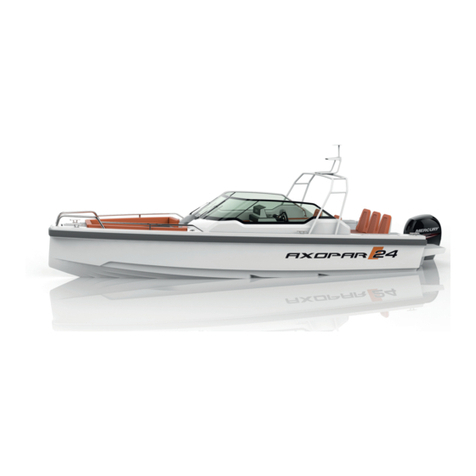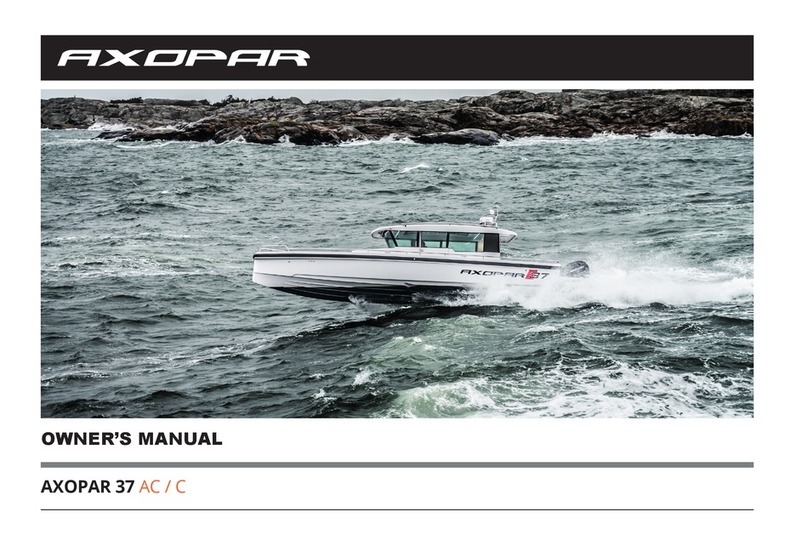3
Table of Contents
FOREWORD 4
1 GENERAL 6
1.1 CE-LUOKITUS................................................ 6
1.1.1 IDENTIFICATION........................................ 7
1.1.2 MANUFACTURER’S PLATE ........................ 7
1.1.3 ID OF NOTIFIED AUTHORITY ................... 7
1.2 TECHNICAL DATA......................................... 8
1.2.1 LOADING CATEGORY B ............................ 8
1.2.2 LOADING CATEGORY C ............................ 9
1.2.3 GENERAL FACTS........................................ 10
1.3 DECLARATION OF CONFORMITY
AND ESSENTIAL SECURITY REQUIREMENTS ... 10
1.4 GENERAL LAYOUT........................................ 11
2 STABILITY AND BUOYANCY 12
2.1 GENERAL ...................................................... 12
2.2 SELF DRAINING SYSTEMS ........................... 12
2.3 DOORS, HATCHES AND SEACOCKS ........... 12
2.4 BILGE PUMP SYSTEM................................... 14
3 BOAT OPERATION 15
3.1 HANDLING DEVICES OF BOAT ................... 15
3.1.1 STEERING CONSOLE ................................ 15
3.1.2 STEERING SYSTEM .................................... 16
3.1.3 ENGINE STARTING.................................... 16
3.2 BOAT HANDLING ......................................... 17
3.2.1 BEFORE LEAVING HARBOUR ................... 17
3.2.2 LEAVING THE JETTY................................... 17
3.2.3 DRIVING THE BOAT .................................. 18
3.2.4 VISIBILITY FROM HELMING POSITION.... 20
3.2.5 USING THE TRIM TABS ............................ 20
3.3 PREVENTING FALLING OVERBOARD
AND HOW TO GET BACK ON BOARD............... 21
3.4 ANCHRORING, DOCKING AND MOORING 22
3.4.1 LIFTING AND TRANSPORTING................. 24
4 ELECTRICAL SYSTEM 25
4.1 DIAGRAM OF THE ELECTRICAL SYSTEM .... 25
4.2.1 MAIN SWITCHES........................................ 26
4.2 12 V SYSTEM................................................. 26
4.2.2 DIRECT SUPPLY SWITCHES ...................... 27
4.2.3 FUSES ......................................................... 28
4.2.4 HEAVY DUTY FUSES .................................. 29
4.2.5 BATTERIES.................................................. 29
4.3 230 V SYSTEM............................................... 30
5 TECHNICAL SYSTEMS 31
5.1 FUEL SYSTEM................................................ 31
5.2 FRESH WATER SYSTEM................................ 32
5.3 SEPTICSYSTEM.............................................. 33
5.4 HEATING SYSTEM......................................... 34
5.5 LPG SYSTEM.................................................. 35
5.5.1 LIGHTING THE LPG COOKER .................. 36
5.5.2 THE LPG USE ............................................. 36
5.5.3 BOW THRUSTER........................................ 36
5.5.4 ANCHOR WINDLASS................................. 37
6 SAFETY.............................................................. 38
6.1 GENERAL 38
6.2 FIRE CONTROL ............................................. 38
6.2.1 BOAT OWNER’S/USER’S
RESPONSIBILITY ................................................. 38
6.3 LIFE RAFT STORAGE..................................... 39
6.3.1 USE OF LIFE RAFT...................................... 39
6.4 GENERAL SAFETY DIAGRAM ....................... 39
7 MAINTEANCE 40
7.1 MAINTENANCE ............................................ 40
7.2 WOODEN INTERIOR..................................... 40
7.3 CLEANING ..................................................... 40
7.4 COVER ........................................................... 40
7.5 PREVENTING FROST DAMAGE ................... 41
7.6 ACTIONS BEFORE WINTER STORAGE ........ 41
7.7 ACTION BEFORE LAUNCHING .................... 41
8 THE ENVIROMENT 42
9 APPENDICES 43
9.1 WARRANTY POLICY ..................................... 43
9.2 ELECTRIC DIAGRAM..................................... 43






